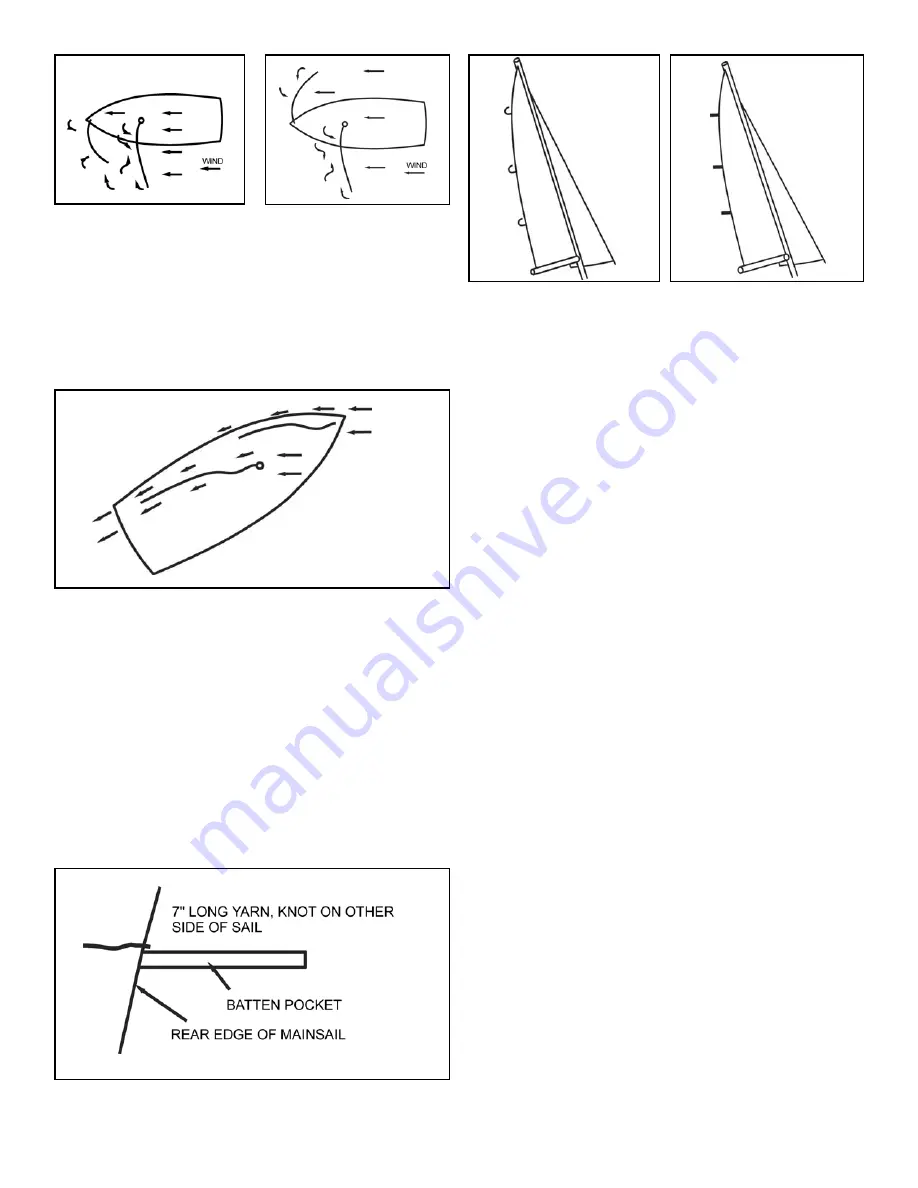
When sailing at right angles to the wind (called “reaching”), pull
in the mainsail control line (mainsheet) and the jib control line
(jibsheet) until the wind completely fills the sails.
If the sails are not pulled in far enough, the fabric near the lead-
ing edge will flutter and ripple. This is the result of the wind hit-
ting the sail on the wrong side and forcing the fabric toward the
upwind side. This fluttering is shown in the following drawing.
Keep pulling the mainsheet in until the fluttering just disappears,
and the sail forms a smooth curve from the mast to the rear edge.
Unfortunately, the sail will not tell you if it is pulled in too far; it
will still look smooth and full, but will not move the boat well. Let
the mainsheet out until the fluttering and bubble reappear along
the mast. Then pull the sail in until the fluttering and bubble just
disappear. This is now the perfect sail setting. Because the wind
is always changing, you have to keep making this test for top per-
formance.
There is another neat trick to let you know when the mainsail is
pulled in too far. Secure a 7” long piece of yarn near the rear end
of every batten pocket. Use a large needle to push the yarn
through the sail.
Mainsail streamer
When the sails are in too far, the yarns will curl around the back-
side of the sail.
If they curl, gently let out the mainsail until they stream out
straight and not try to hide behind the sail. The yarns tell when
the sail is in too tight (which really slows up the boat and causes
it to lean over more), but they do nothing to tell you when the sail
is let out too far.
Even if you point the boat straight into the wind and the sail is
doing an impersonation of a flapping flag, the yarns will stream
nicely to the rear. You have to watch for the fluttering and bal-
looning to appear at the front edge of the mainsail. Pull it in until
the fluttering disappears. So, the fluttering tells you if it is out too
far, and the yarns tell you if it is in too far.
Trimming the jib is just about the same as trimming the mainsail.
The jib, however, comes with built in streamers (called “tell-
tales”) to make it easy. The streamers are about 12” in from the
front edge of the sail. There are 2 sets, evenly spaced up the sail.
When the sail is pulled in just right, all of the streamers, on both
the upwind and downwind sides of the sail, will be flowing
straight to the rear.
When the streamers on the downwind side are going around in cir-
cles and not flowing to the rear, the jib is pulled in too tight. The
wind cannot make the sharp turn around the front edge of the sail,
and the streamers are caught up in the resulting turbulence. Let
out the sail.
If the streamers on the windward side of the sail are dancing
around and not flowing to the rear, the sail is not pulled in tight
enough. Always trim the jib first, then the mainsail, since the
flow off the jib affects the mainsail trim.
You always have two ways to get the angle of the sails to the wind
just exactly right. You can pull the ropes to change the sail angle,
or you can keep the ropes as they are and steer in a new direction.
The latter is easier on the arms. You may not get exactly where
you want to go, but you will be going a lot faster.
When you are sailing as close as possible into the wind, secure the
sails and adjust the angle of the sails to the wind by steering the
boat into or away from the wind.
Page 24
Normal downwind sailing
Sailing downwind, jib out
Streamers curling--bad
Streamers straight--good
Sails not pulled in enough
Содержание 26 M 2009
Страница 28: ...Page 28...



















